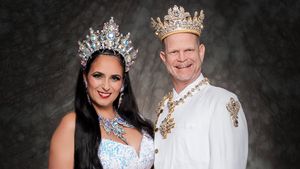With the Supreme Court poised to strike down bans on same-sex marriage nationwide this summer, focus is likely to shift to issues that have been sidelined in favor of fighting for marriage rights. If conservatives have anything to say about it, that focus will be on sex-segregated public facilities such as restrooms, locker rooms, and the like.
The bathroom issue is far from new -- in fact, it's positively ancient. Phyllis Schalfly opposed the Equal Rights Amendment in the 1970s by arguing that it would lead to "unisex bathrooms." Since then, the specter of men in the women's room (notably, not women in the men's room) has frequently been raised as an objection to LGBT nondiscrimination laws, leading GLAAD to denote the phrase "bathroom bill" as defamatory.
It's easy to see why: A 2008 Colorado bill banning discrimination on the basis of religious belief, sexual orientation, or gender identity drew a negative campaign from Focus on the Family that labeled it "the bathroom bill." One newspaper ad features a man in jeans and work boots, described as a "sexual predator" in the ad, waiting for a little girl in a restroom, under the large-print fake headline: "COLORADO JUST OPENED ITS PUBLIC BATHROOMS TO EITHER SEX." The bill wasn't about bathrooms specifically -- it pertained to public accommodations generally: housing as well as other areas where nondiscrimination laws generally apply to other characteristics, such as race. Conservatives chose to frame the legislation as a "bathroom bill" to turn an ordinary nondiscrimination bill into something scary and controversial.
That construct marks a distinct difference from the "bathroom bills" of today. These bills aren't about nondiscrimination generally: They are introduced by conservative legislators with the intent of making bathrooms less safe for transgender people by barring them from facilities that are consistent with their sex and gender identity in favor of facilities consistent with a person's sex assignment at birth or their chromosomes.
While nondiscrimination laws continue to draw criticism as "bathroom bills," the new form started in Florida, with a bill proposed by Republican Rep. Frank Artiles that would make using a restroom not consistent with a person's sex assignment at birth a first-degree misdemeanor, punishable by up to a year in jail. New bathroom bills sprouted up in Kentucky, focusing on transgender students, and in Texas, where a bounty of over $2,000 has been proposed for anyone who finds a transgender person in a public restroom.
Perhaps most egregiously, however, a bathroom bill was attached as an amendment to Canada's Bill C-279. The bill, which proposed adding gender identity to the prohibited grounds of discrimination and as a protected trait regarding hate crimes, has been under debate in multiple legislative forms for nearly a decade. After the bill made it through the House of Commons, there were hopes that it could finally become law, but it was attacked with a poison-pill amendment by Conservative Sen. Don Plett that would prohibit transgender and nonbinary people from using restrooms consistent with their gender identity. Liberals in the Senate attempted to remove the provision but were unsuccessful. At this time, it appears that the poison pill worked, and transgender residents of Canada will continue to have to wait to be explicitly protected by law against discrimination.
As these examples show, the fight over transgender people and restrooms was never truly resolved; it was brushed aside in favor of heteronormative advocacy for marriage equality and generally applicable nondiscrimination laws that only vaguely allude to restrooms.
By making sure the scope of nondiscrimination laws and ordinances extend to sexual orientation and gender identity, activists were largely successful in delaying the fight, but it's been avoided rather than won. That means attacks such as these will continue to happen. They will continue to meet some degree of success, given that public opinion still reveals startlingly retrograde views about LGBT people in general. So as long as transgender people are seen as less authentic than cisgender (nontrans) people, the idea of transgender people in public bathrooms will still incite the sort of fear that drives this legislation.
Fortunately, at least in the United States, the impact of these bills will be limited. The Department of Justice has finally engaged, and has now unequivocally said that discrimination on the basis of gender identity, which these bills engage in, is discrimination on the basis of sex under Title VII of the Civil Rights Act. That determination presumably also applies to the Fourteenth Amendment, suggesting that state action to discriminate against transgender people will receive substantial scrutiny from the judiciary.
Further, in the context of schools, the Department of Education has on several occasions taken enforcement action against school districts that prohibit transgender students from using restrooms consistent with their gender identity. The department has also clearly stated in informal guidance provided in response to questioning that, "when a school elects to separate or treat students differently on the basis of sex in [sex-segregated facilities such as restrooms or locker facilities], a school generally must treat transgender students consistent with their gender identity." So if any of these bills pass in the United States, one can expect that it will face immediate challenge and likely be enjoined by reviewing courts.
However, the example of the Canadian nondiscrimination bill shows that advocates cannot be lax. Even if the bills themselves are unable to become law or be enforced, it is clear that there is enough traction in such legislative efforts to still end generally applicable nondiscrimination laws. Given that the issue of marriage equality is likely to be resolved this year, activists need to continue the hard work of fighting the attitudes that allow these bills to proliferate.
EMILY PRINCE is a regulatory attorney and independent transgender activist. Her work can be found at https://www.emily-esque.com and on Twitter @emily_esque. Her words are her own and do not reflect the views of the United States government.

















































































